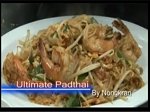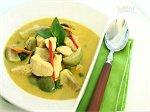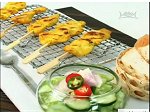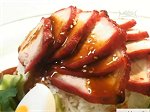 |
Lime (Manao)
The limes in Thailand are smaller, juicier and
have thinner skin. They are not the same version I was used
to in the US. However, they are the same which are grown in
Mexico, Central America, Caribbean, and the Florida Keys. In
the US they are referred to ‘Key Lime’, since they are grown
in the Keys. The ‘key lime’ is native to South East Asia,
and was brought over to to Central America & the Caribbean
by the Spanish, via the Middle East. |
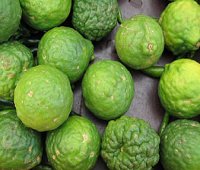 |
Kaffir Lime (Ma Kgroot)
Ma-kgroot are a type of citrus, related to lime,
but with a completely different smell and taste. The juice
(what little there is) is not used. The skin of the fruit is
used in curry pastes, and the leaves are used to flavor
soups, curries and more.
It may be next to impossible to find fresh ma-kgroot outside
of Thailand. You may be able to find frozen or dried. If
frozen, double the amount called for in the recipe, as
freezing the fruit makes it lose flavor. If dried, pre-soak
to soften, and use three times what the recipe calls for. |
 |
Tamarind (Ma Kham)
This brown, acidic fruit is shaped like a large,
broad bean that grows on the tamarind tree. The tamarind
seed is used widely in Southeast Asian cooking. To make
tamarind water, combine 2 to 3 ounces of tamarind pulp with
1 cup boiling water in a non-metallic bowl. Mash the mixture
with a fork and soak for 10 to 15 minutes. Strain by rubbing
through a sieve. Tamarind juice is also available in cans. |
 |
Mango (Ma Muang)
Mangos are available in many shapes and sizes and from all
corners of the globe. The smooth, leathery skin of the mango
can range from yellow to red to green. Ripe mango flesh is
sweet and yellow to orange in color. Mangos are enjoyed
fresh, dried, and and in desserts and drinks. Some varieties
of mango are enjoyed while not fully ripe, giving the flesh
a crisp, sour taste.
Mangos are a popular fruit that grows all over Thailand.
When they are unripe they are green and very sour and we eat
them with chilli and sugar and something salty. When they
ripen they become soft and yellow and suitable for desserts. |
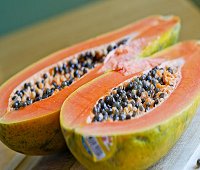 |
Papaya or Pawpaw (Ma la
kaw)
Papaya is known as the "power fruit" as it is
used as a universal remedy for many health disorders and
diseases. It contains beneficial enzymes and has a high
antioxidant content. It strengthens the immune system, helps
the digestive system and protects against free radicals. |
 |
Banana (Gluay)
Bananas are available all year round, and are
eaten fresh, grilled, dried and made into candy. People also
eat the flowers, and use the leaves for steaming. |
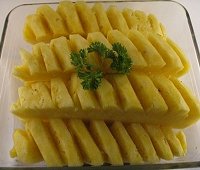 |
Pineapple (Soparot)
There are two main types of Pineapples grown in
Thailand, the softer and sweeter ‘Sri Racha’ variety grown
in the coastal areas around Bangkok, and the crunchier and
more sour ‘Phuket’ variety grown in the South. Pineapples
grow very easily here, and are exported all over the world. |
 |
Coconut (Maprao)
The flesh of mature, ripe coconut is used in a variety of
ways. It is shredded, toasted, and eaten with savory foods,
cooked into desserts, or shredded and pressed with water to
make coconut milk. |
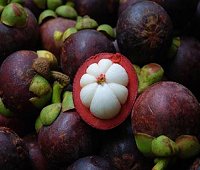 |
Mangosteen (Mahng Khoot)
Mangosteen is a dark purple fruit
(white on the inside) from Southeast-Asia, Thailand being
one of its largest producers. Ripened mangosteen is
roughly the same size as a mandarin orange, with a
reddish-purple rind.
An interesting fact about mangosteen is that there is
always a type of scar at one end. This is a remnant of the
flower, and the number of remnant flower parts contained in
the scar will tell you how many segments of fruit are
inside. Besides containing more fruit, mangosteen that has
the most segments will also have fewer seeds. The fruit
itself is sweet, with a texture that has been likened to a
ripe plum. It is rich in phosphorus and calcium, and
vitamins B and C. |
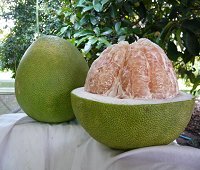 |
Pomelo or Thai Grapefruit
(Som Oh)
The pomelo is a citrus fruit native to Southeast
Asia. It is usually pale green to yellow when ripe, with
sweet white (or, more rarely, pink or red) flesh and very
thick pudgy rind. It is the largest citrus fruit, 15–25 cm
in diameter, and usually weighing 1–2 kg.The pomelo
tastes like a sweet, mild grapefruit, though the typical
pomelo is much larger in size than the grapefruit. It has
very little, or none, of the common grapefruit's bitterness,
but the enveloping membranous material around the segments
is bitter, considered inedible, and thus usually is
discarded. |
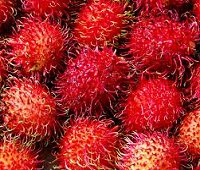 |
Rambutan (Ngor)
Rambutans are very pretty Thai fruit, slightly sweet but
with a fairly bland taste and jelly texture. Cut around the
middle of the skin twist and the skin will come off. Eat the
flesh, leave the stone. |
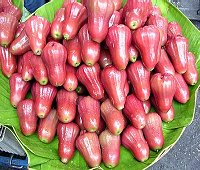 |
Rose Apple (Chompoo)
The Rose Apple, Mountain Apple is very common in
Thailand. From bright red to pink or green, the Rose Apple
is bell shaped and similar in texture to an apple but
sweeter.
Most often eaten fresh but also nice mixed with shrimp in a
spicy salad |
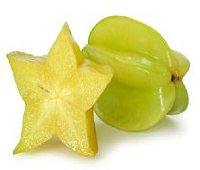 |
Star Fruit (Ma-Ferng)
Originally from India, the star fruit has smooth,
yellow skin with five lateral ridges running the length of
the fruit. Cut width-wise, the fruit has a pleasant star
shape, making it attractive as a garnish and in fruit
salads. The star fruit is crisp and sweet. Star Fruit is
rich in antioxidants and Vitamin C. |
 |
Durian (Dturian)
Weighing in at around 4 pounds and 1 foot long
and 6 inches wide this ovoid, thorn-covered fruit looks more
like something that would be dropped out of a B-52 at high
altitude rather than fetch top dollar in the markets of
Southeast Asia. You either love Durian or hate it. Most
locals love it and Durian is one of the most popular fruits
in Thailand. |
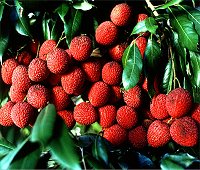 |
Lychee (Linchee)
The bright red fruit of the Lychee (linchee) is
just smaller than a golf ball with a rind similar to the
golf ball but with pimples rather the dimples. Firm presure
with the thumbs breaks the rind and reveals the white fleshy
fruit that is very sweet and rich in vitamin C. The seed
inside the fruit is not edible. The fruit is available only
a few months a year but is easily canned and is often served
as desert in Thai and Chinese restaurants.
|
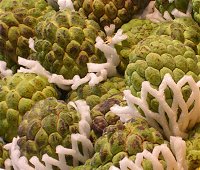 |
Custard Apple (Noi Na)
The Custard Apple is sweet but very seedy. The skin of the
ripe fruit is green with many segments. |
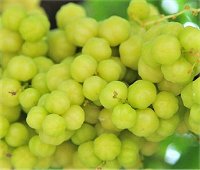 |
Star Gooseberry (Ma yom)
The Star Gooseberry is very common around Thai
houses. The tree is said to bring good fortune to the
residents and it produces many small tart fruits in a short
time. It makes a small shade tree but in fruiting season
drops fruits almost to fast to keep up with, even with
children in the house, among whom the fruit is very popular. |
 |
Guava (Falang)
One seldom sees a ripe Guava in Thailand as Thais
prefer to the fruit raw, dipped in salt or sugar mixed with
driel chilis. An unripen Guava reminds one of the texture of
a ripe apple. Guava juice is readily available and is rich
in vitamin C.Raw guavas are eaten out-of-hand, but are
preferred seeded and served sliced as dessert or in salads.
More commonly, the fruit is cooked and cooking eliminates
the strong odor. |
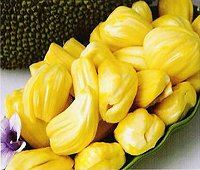 |
Jackfruit (Kanoon)
Weighing up to 80 pounds and a yard long, the
Jackfruit is the largest tree borne fruit in the world.
Broken open, the Jackfruit reveals dozens of large seeds
covered with a sweet yellow sheath which has a taste similar
to pineapple but milder and less juicy. It is said that the
flavor of Juicy Fruit chewing gum comes from the Jackfruit. |
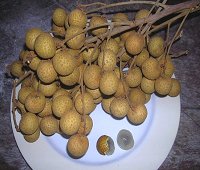 |
Longon (Lam yai)
The longan or "dragon eyes" is so named because
of the fruit's resemblance to an eyeball when it is shelled
(the black seed shows through the translucent flesh like a
pupil/iris). The seed is small, round and hard and closely
allied to the glamorous lychee. The fruit is edible, and is
often used in East Asian soups, snacks, desserts, and
sweet-and-sour foods, either fresh or dried, sometimes
canned with syrup in supermarkets. The seeds of fresh longan
can be boiled and eaten, with a distinctive nutty flavor |
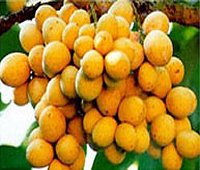 |
Langsart (Lansart)
Langsart are a sweet fruit with a pale brown skin
with an inner stone which is quite bitter. The fruit hang in
bunches of 8 to 20 pieces. The smooth outer skin is a dirty
yellow color. Under the thin peel, which exudes a milky sap,
are about five white or pinkish segments unequal in size.
Most segments are sweet, but one or two contain a viable
seed and are very bitter to the taste. |
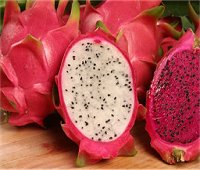 |
Dragon Fruit (
one of the most beautiful exotic fruits: a bright
purple-red skin that hides pitaya crisp tender white flesh,
strewn with many tiny black seeds. On the palate the fruit
is sweet and sour. Very thirst quenching. Dragon Fruit is
highly recommended for diabetics and people with other
diseases of endocrine system. Helps with stomach pains.
Promotes weight loss. |
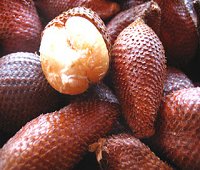 |
Sala (Sa La)
Sala has a fibrous center with a complex flavour,
I'm told it tastes of sherry trifle with slightly bitters
notes next to the sweetness. If you want to try one Thai
fruit this is the one I'd go for. Sala also forms the basis
for many cream soda drinks. |
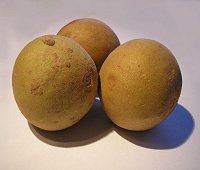 |
Sapodila (Lamut)
sweet and juicy fruit with smaller seeds between
the fibers. The shape resembles a rugby ball, with the size
of kiwi. Sapodilla has a thin inedible skin, which easily
exposes the soft brown flesh. As food it is consumed only in
mature form, when the fruit becomes soft and dark-brown
outside. It has a high content of vitamins C and A and
calcium. |
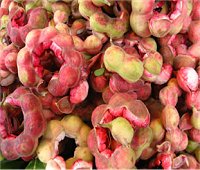 |
Camachile or Malaysian
Tamarind (Makaam Thet)
Its fruits are similar
to those of the tamarind
tree but has a softer
skin and a different
taste. Its tender curly
skin is red-green and
its whitish-pink flesh
sits around shiny brown
seeds. The tree for
this grows wild in north
east Thailand, it's not
cultivated and the
berries are not sold,
but they are eaten by
children. The older the
berries are, the more
they turn red, and the
redder they are, the
sweeter they are. Peel
off the outer husk and
eat the pulp minus the
seed.
|





























